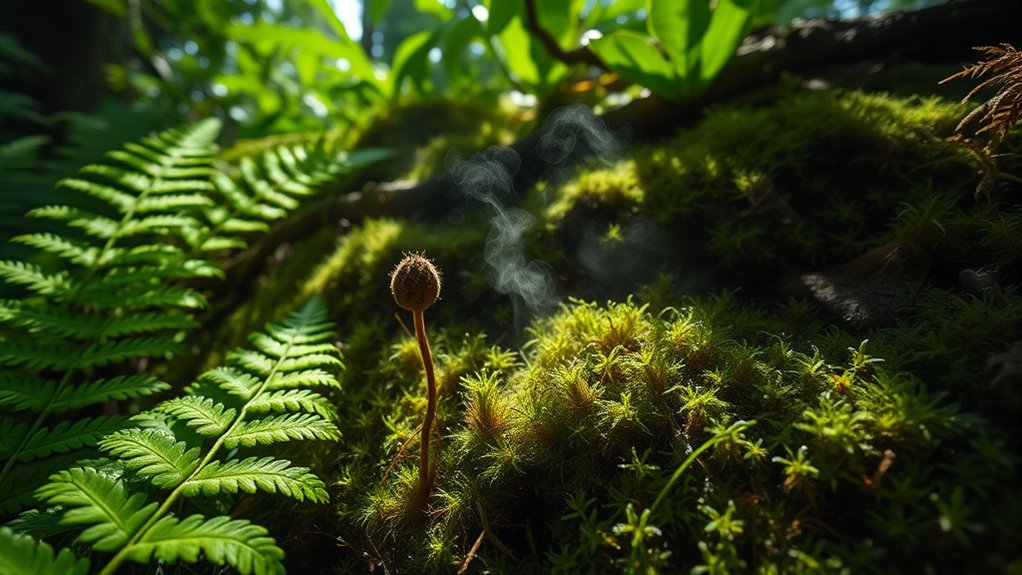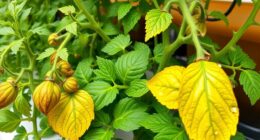Plants use chemicals, known as allelochemicals, to compete by inhibiting their neighbors’ growth and seed germination. They release these substances into the soil to secure resources like water, nutrients, and sunlight. This chemical warfare helps some species dominate while others coexist peacefully, maintaining balance in crowded environments. If you want to discover how these natural interactions shape plant communities and influence ecosystems, there’s much more to explore below.
Key Takeaways
- Plants release allelochemicals into the soil to inhibit the germination and growth of competing plants.
- Allelopathy allows dominant species to secure resources by suppressing neighbors through chemical signals.
- Chemical signaling in plants fosters coexistence by attracting beneficial microbes and deterring pests.
- Allelochemicals help maintain ecological balance by preventing overgrowth of weaker or competing species.
- This chemical warfare shapes plant communities, promoting diversity and resource sharing in crowded environments.

Have you ever wondered how some plants manage to thrive alongside their neighbors without being overtaken? The secret often lies in chemical signaling, a sophisticated form of communication that influences competitive interactions. Plants don’t just grow randomly; they actively monitor their surroundings and respond accordingly. When a neighboring plant starts to grow too aggressively or encroach on their space, they can release specific chemicals into the soil. These chemicals serve as signals, alerting the plant to potential threats or competition. By doing this, they can adjust their growth patterns, either by allocating resources differently or by producing compounds that inhibit the growth of rivals. This dynamic process helps them carve out their niche and maintain a balance in crowded environments.
In these competitive interactions, allelopathy plays a pivotal role. It’s a natural strategy where plants produce and release chemicals—allelochemicals—that impact other plants in their vicinity. These chemicals can prevent seed germination, stunt seedling growth, or reduce the overall vigor of competing plants. For example, you might notice how certain trees or shrubs dominate a landscape, not just by their size, but because they emit compounds that suppress the growth of other species. This chemical warfare isn’t random; it’s a finely tuned mechanism that helps the dominant plant secure resources like water, nutrients, and sunlight. Without it, the competitive landscape would be much more chaotic, with weaker plants constantly being overtaken or outcompeted.
Additionally, research shows that many plants have evolved to produce allelochemicals as part of their cultural adaptations, which help them survive in diverse and sometimes harsh environments. Chemical signaling doesn’t only serve as a weapon; it also fosters coexistence. Some plants release chemicals that attract beneficial microbes or symbiotic fungi, which can help them absorb nutrients more efficiently. Others might produce substances that deter herbivores or pests, indirectly benefiting neighboring plants by reducing threats in the environment. This complex web of chemical interactions enables plants to coexist in diverse communities, each species playing its role without completely overwhelming the others. It’s a delicate balance, maintained through these biochemical dialogues that shape plant behavior and interactions.
Frequently Asked Questions
Can Allelopathy Influence Agricultural Crop Yields?
You might wonder if allelopathy can influence crop yields. It definitely can, as allelopathic interference from certain plants releases chemicals that inhibit or promote growth. This can lead to crop yield enhancement if managed properly, or reduce yields if harmful allelopathic effects occur. Understanding these interactions helps you optimize planting strategies and minimize negative impacts, ultimately improving productivity and sustainable farming practices.
Are All Plant Species Capable of Producing Allelochemicals?
Not all plant species produce allelochemicals, as plant chemical diversity varies widely across species. You’ll find significant species variation in the ability to generate these chemicals, which are used to inhibit competitors. While many plants have evolved to produce allelochemicals as a survival strategy, others rely on different mechanisms. So, it’s incorrect to assume every plant species can produce allelochemicals; it depends on their unique adaptations and ecological roles.
How Do Environmental Factors Affect Allelopathic Interactions?
Think of allelopathy as a delicate dance choreographed by nature, where environmental factors set the rhythm. Soil moisture and temperature fluctuations act like the changing weather, influencing how plants release or absorb allelochemicals. When the soil is moist, chemicals spread more easily, intensifying interactions. Conversely, temperature swings can either boost or hinder chemical production, making allelopathic effects unpredictable—like dancers adapting to shifting conditions.
Can Allelopathy Be Harnessed for Natural Weed Control?
You can harness allelopathy for natural weed suppression by using plants that release chemicals inhibiting weed growth. This eco-friendly approach acts as a natural herbicide, reducing the need for synthetic chemicals. Incorporating allelopathic species into your garden or farm creates a sustainable, environmentally conscious weed control method. It’s a smart way to promote healthy plant competition while minimizing ecological impact, making your landscape more resilient and eco-friendly.
Are There Any Negative Effects of Allelochemicals on Soil Health?
You might wonder if allelochemicals harm soil health. They can contribute to soil degradation by disrupting microbial balance, which is essential for nutrient cycling. When these chemicals accumulate, they may suppress beneficial microbes, leading to reduced soil fertility and structure. However, the extent of negative effects depends on the concentration and type of allelochemicals released. Proper management can minimize potential harm, ensuring soil remains healthy and productive.
Conclusion
Just as Odysseus relied on clever tricks to navigate treacherous waters, plants use allelopathy to outsmart rivals and thrive. Their secret weapon—chemical warfare—shapes the forest’s silent battles, allowing some to dominate while others coexist. By understanding this natural strategy, you see nature’s grand chess game at play, where every leaf and root has a role. Embrace the complexity, knowing that in the plant kingdom, chemistry and competition intertwine in a timeless dance.









